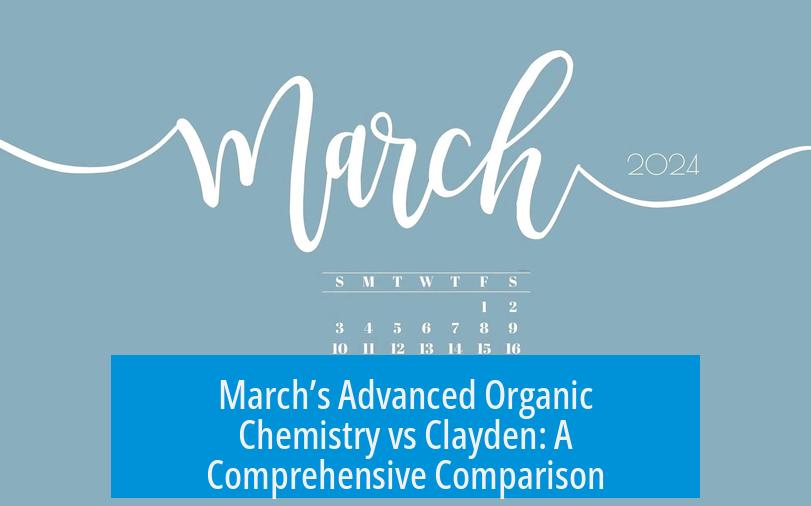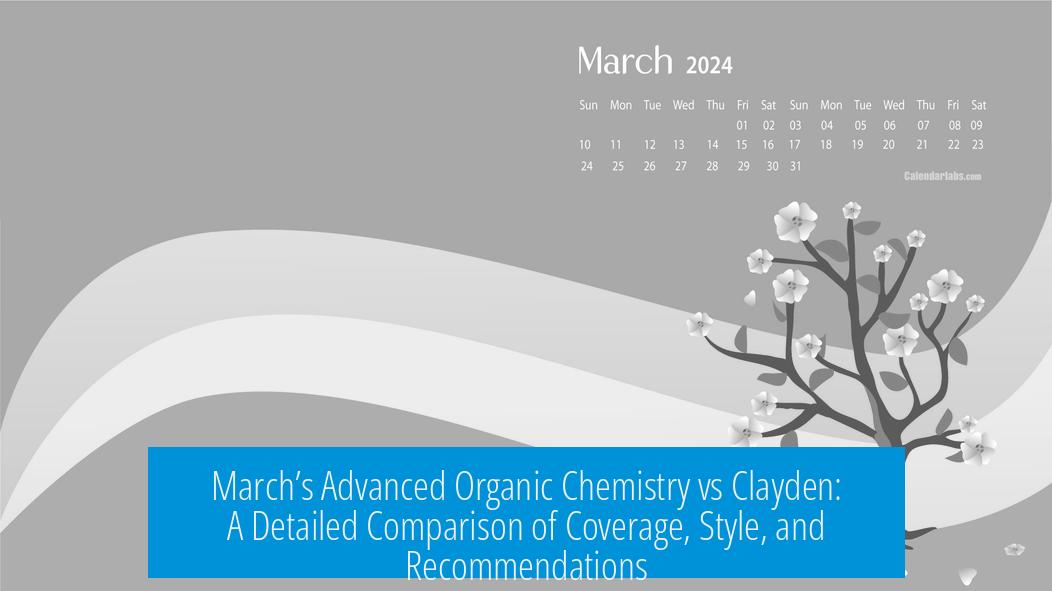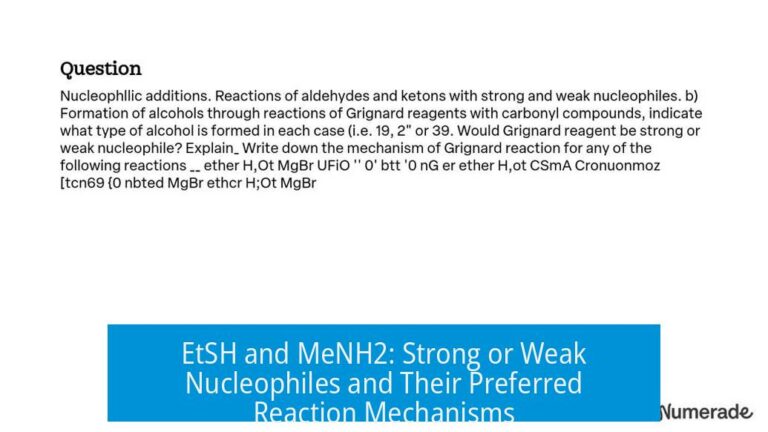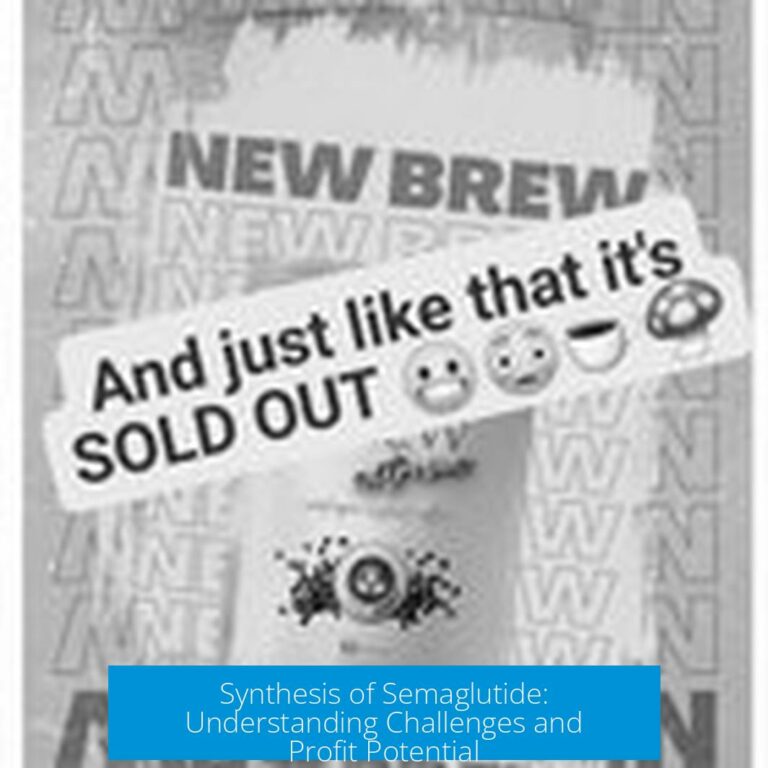March’s Advanced Organic Chemistry vs Clayden: A Comprehensive Comparison

March’s Advanced Organic Chemistry and Clayden’s Organic Chemistry differ significantly in style, coverage, readability, and usage. March serves as an encyclopedic reference packed with extensive literature citations. Clayden offers an engaging, guided learning experience with easier readability and interactive features. Combining both texts provides a strong foundation for advanced organic chemistry study.
1. Coverage and Scope
March’s Advanced Organic Chemistry acts as a comprehensive encyclopedia. It contains detailed explanations with many references to primary literature, including Organic Syntheses procedures. This design makes it a powerful resource for in-depth research and specialized topics.
In contrast, Clayden’s text spans multiple volumes with an accompanying solutions manual. It guides the learner progressively through organic chemistry concepts via “boot camps,” creating a structured, step-by-step learning journey. Its interactive approach supports gradual skill-building and conceptual reinforcement.
| Aspect | March’s Advanced Organic Chemistry | Clayden’s Organic Chemistry |
|---|---|---|
| Coverage | Encyclopedic, extensive literature references | Interactive, journey-like with boot camps |
2. Accessibility and Readability
March’s book is text-heavy and dense, with relatively few illustrations. This format can challenge readers, particularly visual learners or those new to advanced concepts. Its language and structure demand focused attention and prior organic chemistry knowledge.
Clayden is designed to be more accessible. Its writing is clearer and supplemented with numerous diagrams. Readers often find it easier to read and grasp. It is well suited for students refreshing undergraduate organic chemistry concepts or those beginning advanced studies.
- March’s text is challenging and less visual.
- Clayden’s text reads more smoothly and includes helpful illustrations.
- Clayden supports learners with a structured, interactive approach.
3. Best Usage Contexts

March’s Advanced Organic Chemistry works best as a detailed reference book. Researchers and graduate students turn to it when needing comprehensive information on reaction mechanisms or synthetic methods. It serves well as a guide to extensive literature and experimental procedures.
Clayden’s text is ideal for groundwork and review. It helps students revisit essential concepts and build strong foundations before tackling specialized topics. Its pacing suits classroom instruction or self-study during earlier phases of graduate education.
Using both books together is highly effective. Clayden lays the conceptual framework early on. March then supports with detailed expansions, examples, and references to primary literature. This complementary approach paves the way to deeper mastery and research readiness.
4. Style and Presentation
March’s style resembles an encyclopedia: detailed, dense, and densely packed with references and complex information without much informal guidance. It suits readers comfortable navigating advanced texts and consulting primary sources.
Clayden takes a more narrative and engaging style. It leads readers through challenging concepts via examples, exercises, and “boot camps.” This style appeals to learners who prefer structured paths and explanatory prose.
5. Personal Preferences and Recommendations
Many students and professionals recommend starting with Clayden’s books. Its readability and structured approach make it a better entry point into advanced organic chemistry topics. It helps refresh memory and connect undergraduate knowledge to research-level material.
March’s book suits those needing exhaustive depth, frequent literature citation, and reference material for experimental planning or theoretical study. It complements Clayden by filling in details after foundational concepts are well understood.
Other advanced texts, like Carey’s Advanced Organic Chemistry volumes, also offer focused coverage on structures, mechanisms, and synthesis. These can supplement or compete with March depending on the learner’s focus.
Repeated study is crucial when engaging with advanced texts. Mastery does not come from a single reading. Experts recommend studying material multiple times and consulting diverse sources to deepen understanding.
Summary Table of Key Differences
| Factor | March’s Advanced Organic Chemistry | Clayden’s Organic Chemistry |
|---|---|---|
| Content Depth | Extensive, encyclopedic, well referenced | Broad, accessible, concept-focused |
| Readability | Challenging, text heavy, few pictures | Clear, illustrated, easier to follow |
| Intended Use | Reference for research and advanced study | Foundation-building and review |
| Structure | One-volume encyclopedia format | Multi-volume journey with solutions |
| Recommended Study Approach | Consult after mastering basics | Start here for conceptual understanding |
Key Takeaways
- March’s Advanced Organic Chemistry provides detailed, encyclopedic coverage with extensive references.
- Clayden offers a user-friendly, structured learning experience with plenty of visuals and exercises.
- March is best for in-depth research and advanced reference; Clayden is appropriate for foundational learning and review.
- Using both books together enhances understanding and prepares students for specialized studies.
- Repeated study and consulting multiple sources strengthen mastery of organic chemistry.
What makes March’s Advanced Organic Chemistry different in coverage compared to Clayden?
March is an encyclopedic resource packed with extensive literature references, making it very comprehensive. Clayden takes a guided, interactive approach, focusing on progressive learning with multiple components.
Which book is easier for beginners or those refreshing undergraduate concepts?
Clayden’s Organic Chemistry is easier to read and more accessible. It’s recommended to start with Clayden for groundwork before using more detailed texts like March.
Can March and Clayden be used together effectively?
Yes. Their approaches complement each other well. Clayden provides a strong foundation, while March offers detailed references for deeper understanding and specialized topics.
Why might March’s Advanced Organic Chemistry be challenging for some readers?
March’s book is text-heavy and contains fewer illustrations. This can make it harder for visual learners and those who prefer simpler explanations.
What study strategy is suggested when using both March and Clayden?
Repeated study and working through both books as time allows is advised. Starting with Clayden then consulting March helps build mastery gradually, rather than expecting full understanding from one read.





Leave a Comment